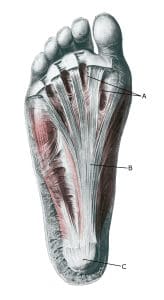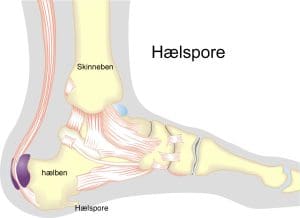Anatomy

A. Aponeurosis plantaris
B. Tuber calcanei
Cause
Inflammation at the attachment of the Achilles tendon under the heel bone is typically seen in children aged 8-12 years. It is caused by an ‘inflammation’ in the growth zone of the heel bone, which is caused by repeated overloads such as running and pushing off.
As the Achilles tendon is a functional extension of the Achilles tendon, the stresses that cause overuse injuries at the attachments of the Achilles tendon and Achilles tendon are often the same. Inflammation of the Achilles tendon attachment on the heel bone is often seen in combination with inflammation of the Achilles tendon attachment on the heel bone (Mb Sever) ( Kothars EA. et al., 2023 ).
Symptoms
Pain when running and standing and pressure on the tailbone attachment just below the heel bone. Usually the pain is most pronounced slightly inside (medial) to the attachment.
Examination
Diagnosis is usually made by general clinical examination, where the known pain can be caused by pressure under the heel at the calcaneal tendon attachment on the heel bone. However, the severity of soreness is not always a measure of the extent of the injury. For more pronounced tenderness or sudden onset of pain, a medical examination is recommended to rule out bone fractures in the foot and ensure proper diagnosis and treatment.
If there is any doubt about the diagnosis, X-rays, ultrasound and possibly MRI scans can be performed, especially in cases of sudden onset of severe pain and suspected tears (which X-rays often miss). An ultrasound scan can assess any inflammation in the tendon.
Treatment
Treatment primarily includes relief from pain-inducing activity (running), stretching and slowly increasing rehabilitation within the pain threshold.
If treatment is started quickly, the injury can sometimes heal in a matter of weeks. If the pain has been present for several months before relief is applied, a rehabilitation programme lasting several months (half a year) is often required. Running shoes with a shock-absorbing heel are recommended.
Adrenal cortical hormone injection or surgery is not indicated in children.
Heel spur
‘Inflammation’ (inflammation) of the arch tendon (plantar fasciitis) is sometimes associated with a heel spur. A heel spur is a bone degeneration caused by prolonged overuse-induced ‘inflammation’ at the arch tendon attachment on the heel bone.
The heel spur is thus a consequence of the overuse injury and not the cause. Once a heel spur has formed, it never goes away. The heel spur has no practical significance and does not require treatment. Many asymptomatic athletes have a heel spur without having had symptoms from the arch tendon attachment.

Bandage
Evidence for the value of tape in tendon problems is limited but can be attempted as the tape does no harm if applied correctly, see tape 1 and tape 2
Complications
If progress is not smooth, consider the following:
Especially
It is crucial to react to the first soreness or pain so that training can be reorganised and the course shortened.
